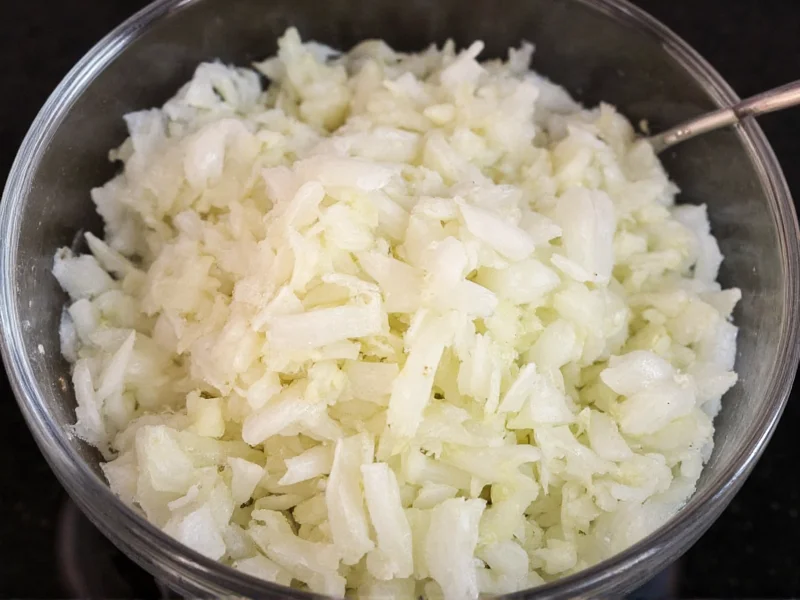The Science Behind Onion Conversions
Understanding why the grated onion to onion powder conversion isn't a simple 1:1 substitution requires examining their fundamental differences. Fresh onions contain approximately 89% water, while onion powder is dehydrated to about 6% moisture content. This dramatic reduction explains why you need three times more volume of grated onion to match the concentrated flavor compounds in onion powder.
When converting recipes calling for grated onion to onion powder, remember that the powder delivers more intense onion flavor per volume unit. The drying process concentrates sulfur compounds responsible for onion's characteristic taste, making powder significantly stronger than its fresh counterpart. This knowledge helps prevent over-seasoning disasters in your cooking.
Practical Conversion Guide for Home Cooks
Accurate measurement is crucial when substituting between these forms. Use this reliable conversion chart for perfect results every time:
| Grated Fresh Onion | Onion Powder Equivalent | Best For |
|---|---|---|
| 1 tablespoon | 1 teaspoon | Sauces, dressings, marinades|
| ¼ cup | 1¼ tablespoons | Casseroles, meatloaf, soups|
| ½ cup | 2½ tablespoons | Stews, chili, hearty dishes|
| 1 cup | 5 tablespoons | Large batch cooking, commercial recipes
When Substitutions Work Best (and When They Don't)
Not all recipes tolerate this substitution equally. Understanding grated onion vs onion powder applications prevents culinary mishaps:
Use onion powder when: Making dry rubs, spice blends, or recipes where moisture content matters (like meatloaf binding). The powder integrates seamlessly without adding liquid that could affect texture.
Stick with grated onion when: Preparing fresh salsas, salads, or dishes where texture contributes to the eating experience. The moisture and crunch provide elements powder can't replicate.
For onion powder measurement in recipes requiring precise liquid balance, reduce other liquids by 1-2 teaspoons per tablespoon of powder substituted. This adjustment compensates for the water content difference between fresh and dried forms.
Flavor Profile Considerations
Onion powder delivers a more consistent, mellow flavor compared to fresh onion's sharp bite. The drying process transforms allicin compounds, creating different flavor notes. While fresh onion provides bright, pungent top notes, powder offers deeper, caramelized undertones.
When making the fresh onion to dried onion powder conversion, consider adding a pinch of sugar to mimic the natural sweetness of fresh onions. For recipes where onion's sharpness is essential (like French onion soup), supplement powder with a dash of vinegar to restore that characteristic bite.
Troubleshooting Common Substitution Problems
Problem: Dish tastes too salty after substitution
Solution: Many commercial onion powders contain anti-caking agents with sodium. Reduce added salt by 25% when using powder instead of fresh.
Problem: Flavor seems weak despite correct measurements
Solution: Bloom the powder in hot oil for 30 seconds before adding other ingredients. This rehydrates and activates flavor compounds for stronger impact.
Problem: Texture issues in binding recipes
Solution: For meatloaf or burgers, combine onion powder with 1 teaspoon olive oil per tablespoon of powder to replace lost moisture and improve binding.
Professional Chef Tips for Perfect Results
Experienced cooks use these advanced techniques when working with onion powder equivalent to fresh onion conversions:
- Make your own powder by dehydrating grated onion at 140°F for 6-8 hours, then grinding to powder - this preserves more nuanced flavors than commercial products
- For delicate sauces, steep onion powder in warm broth for 10 minutes before straining to extract maximum flavor without graininess
- Combine both forms in layered recipes - use powder for base flavor and fresh for finishing touches
Remember that storage affects potency. Onion powder loses 20% of its flavor strength after six months. Always check your spice cabinet dates when making how to substitute grated onion for onion powder decisions for optimal results.
Frequently Asked Questions
Can I use onion powder instead of grated onion in meatloaf?
Yes, use 1½ tablespoons onion powder for every ½ cup grated onion. Since meatloaf needs binding, add one teaspoon olive oil per tablespoon of powder to replace lost moisture and prevent dryness.
Why does my recipe taste different when I substitute onion powder?
Onion powder has concentrated, mellow flavor compared to fresh onion's sharp bite. The drying process changes flavor compounds. For closer flavor matching, add a pinch of sugar and dash of vinegar when substituting.
How do I adjust liquid content when using onion powder instead of fresh?
Reduce other liquids by 1-2 teaspoons per tablespoon of onion powder substituted. For example, if replacing ¼ cup grated onion (4 tablespoons) with 1¼ tablespoons powder, decrease broth or water by 1½-2½ teaspoons.
Does onion powder have the same nutritional value as fresh onion?
Nutritionally, onion powder concentrates certain compounds but loses vitamin C during drying. Per equivalent flavor strength, powder provides more fiber and minerals by weight but less vitamin C than fresh onion.
Can I make my own onion powder from grated onion?
Yes, spread grated onion evenly on dehydrator trays and dry at 140°F for 6-8 hours until brittle. Grind to fine powder in a spice grinder. Store in an airtight container for up to 6 months for best flavor retention.











 浙公网安备
33010002000092号
浙公网安备
33010002000092号 浙B2-20120091-4
浙B2-20120091-4